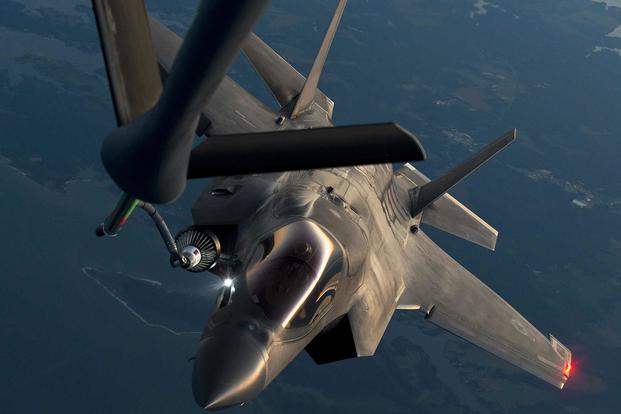A joint-test effort has fixed a dangerous flaw in the F-35 Lightning II that was blinding KC-135 Stratotanker crewmen during night refueling operations.
The Aerial Refueling Certification Agency, located at Wright-Patterson Air Force Base, Ohio, has approved a redesigned refueling probe light on F-35 B and C models, a decision that will soon clear Marine Corps and Navy Lightning II pilots for night refueling operations with the Air Force tanker, Daryl Mayer, a Wright-Patterson spokesman, told Military.com recently.
In March, teams from Naval Air Station Patuxent River, Maryland, and Edwards Air Force Base, California, completed tests of a redesigned light, which attaches to the refueling probe on the F-35B and F-35C.
The existing lighting system was too bright, and the design made it difficult for the KC-135 boom operator to see the silhouette of the F-35. The Air Force requires the boom operator to monitor the process to ensure the pilot safely separates from the refueling boom.
"The current probe light was too bright, blinding the KC-135 aerial refueling boom operators," Michael McGee, 418th Flight Test Squadron (FLTS) aerial refueling project manager at Edwards, said in a news release from Edwards in March. "The new light was designed to be less bright, but still bright enough for the F-35 pilot to see clearly."
The Air Force F-35A does not have a probe, so no change is required for that model.
As part of the test effort, an F-35B from Air Test and Evaluation Squadron 23 at Patuxent River deployed to Edwards, where it was paired with a KC-135 and test aircrew from the 418th FLTS for the test effort.
"For the ground test, we used a hangar," McGee said in the release. "The environment needed to be completely dark. We had to remove emergency lighting from the facility and place mats on the floor to reduce light glare."
The ground test evaluated two types of lights with different color tones -- a warm white light and an amber light -- across various brightness levels.
"The warm white light was determined to be the best choice for both boom operators and pilots," McGee said in the release.
The first flight test lasted four hours and accomplished all of the required test points.
"Our biggest concern was completing the test during the lowest moon illumination, worst-case lighting scenario timeframe, which was March 1-11," McGee said. "For the flight test, we planned a minimum of two flights, but captured all test points on our first flight."
The test results were sent to the Air Refueling Certification Agency, which found that "the design has effectively remedied issues raised with the original light," Mayer told Military.com.
"The F-35B/C aerial refueling clearance will be updated to reflect the ability to refuel at night from the KC-135 once the [F-35 Joint Program Office] has procured enough light kits and introduced them to the fleet," he said.
-- Matthew Cox can be reached at matthew.cox@military.com.












